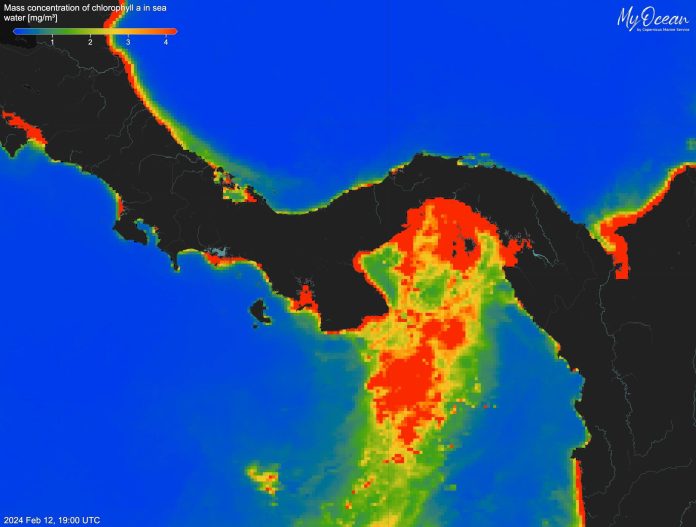The Unforeseen Collapse of Panama’s Coastal Upwelling: A Climate Wake-Up Call
Imagine standing on the shores of Panama, where the gentle crash of ocean waves has been a constant in life. The sun glistens off the water, and vibrant marine life thrives below the surface. For generations, fishermen have relied on the Gulf of Panama’s seasonal upwelling, a natural event where nutrient-rich waters rise from the depths, supporting both fish populations and the overall health of the ecosystem. But in a shocking turn of events, this vital process failed to occur in 2025, marking a significant shift in our planet’s rhythm.
What Happened in 2025?
For the first time on record, the seasonal upwelling in the Gulf of Panama simply did not happen. According to scientists from the Smithsonian Tropical Research Institute (STRI), this unprecedented situation was closely linked to weakened trade winds—a result of climate change that has been gradually altering our oceanic patterns.
Why is Upwelling Important?
So, what exactly is upwelling, and why should we care? Upwelling is essentially nature’s way of recycling nutrients in the ocean. During the dry season in Central America, typically from December to April, northern trade winds drive this process. Deep, cold waters packed with nutrients come to the surface, giving rise to rich marine life, including essential fish species. This natural cycle supports countless jobs, provides food for local communities, and plays a critical role in maintaining ecological balance.
When upwelling is interrupted, the effects can be disastrous. From reducing fish catches, which fishermen rely on for their livelihoods, to increasing stress on coral reefs, the consequences ripple through the ecosystem.
A Closer Look at the Research
Researchers monitored Panama’s upwelling for over 40 years, documenting its consistent patterns. In 2025, however, things changed dramatically. The expected drop in sea temperatures and surge in marine productivity simply didn’t occur. Their study, published in Proceedings of the National Academy of Sciences (PNAS), identified the severe weakening of wind patterns as the likely culprit. This disruption raises alarming questions about the future of marine resources and the communities that depend on them.
“We really need to pinpoint the mechanisms behind these changes,” says Andrew Sellers, a leading figure in the research. His team’s findings highlight not only the immediate effects but also the potential long-term impacts on fisheries and coastal economies.
Visualizing the Change
A series of maps illustrated the unfolding situation. One showed the expected chlorophyll concentrations, with blue indicating low levels and red signifying high productivity. In February 2024, the map glowed with vibrant colors. Fast forward to February 2025, and it almost looked like a blank canvas. This stark contrast illustrates the ecological disaster that struck, as nutrient levels plummeted and productivity vanished.
The Broader Picture: Why Should We All Care?
It’s easy to think that what happens in a far-off ocean can’t affect our daily lives. But the truth is, shifts in ocean climates can have far-reaching consequences. The Gulf of Panama serves as a pivotal survival ground not just for local fishermen but also for global fish markets. Without this seasonal upwelling, food security is at risk.
Additionally, the disruption could lead to more significant climate changes, affecting weather patterns and marine biodiversity. The oceans are deeply connected to our climate systems, and what happens in one place can alter conditions everywhere.
Pressing for Action
The findings from STRI underline a key point: the vulnerability of tropical upwelling systems is becoming increasingly apparent. Despite their ecological and economic importance, these systems remain under-monitored. The urgency to improve ocean-climate observation is more critical than ever.
Collaboration is key here. The research was part of a partnership between the S/Y Eugen Seibold research vessel, operated by the Max Planck Institute for Chemistry, and STRI. Together, they are striving to enhance our understanding of oceanic and atmospheric conditions in the Pacific. This kind of collaborative research will be crucial in navigating the challenges posed by climate change.
Personal Reflections: Why This Matters to Us All
In reflecting on these changes, I can’t help but feel a sense of urgency. I’ve spent a considerable amount of time by the ocean, enjoying its beauty and bounty. Seeing the immediate link between climate change and our oceans drives home a powerful lesson.
We live in an interconnected world. The oceans aren’t just vast expanses of water; they are living, breathing systems that provide for us and support biodiversity. The failure of a single upwelling event may seem small in the grand scheme, but it’s a signal—an early warning of what unchecked climate change can bring.
Being aware of these issues enables us to take action in our daily lives. Whether by reducing our carbon footprint, supporting sustainable fishing practices, or voicing our concerns about climate change—every effort counts.
Conclusion: Our Path Forward
The collapse of Panama’s seasonal upwelling in 2025 is a wake-up call we cannot ignore. It’s not just about fish or coral reefs; it’s about all of us. As we continue to face an uncertain future with climate change, we need to advocate for stronger ocean monitoring and climate policies.
By taking time to understand and act on these issues, we contribute to a healthier planet. Every small action can lead to significant impacts. As we witness changes in our environment, let’s not lose hope but instead become stewards of the natural world that sustains us all. Let’s embrace the responsibilities of that stewardship, keeping our oceans vibrant for generations to come.

